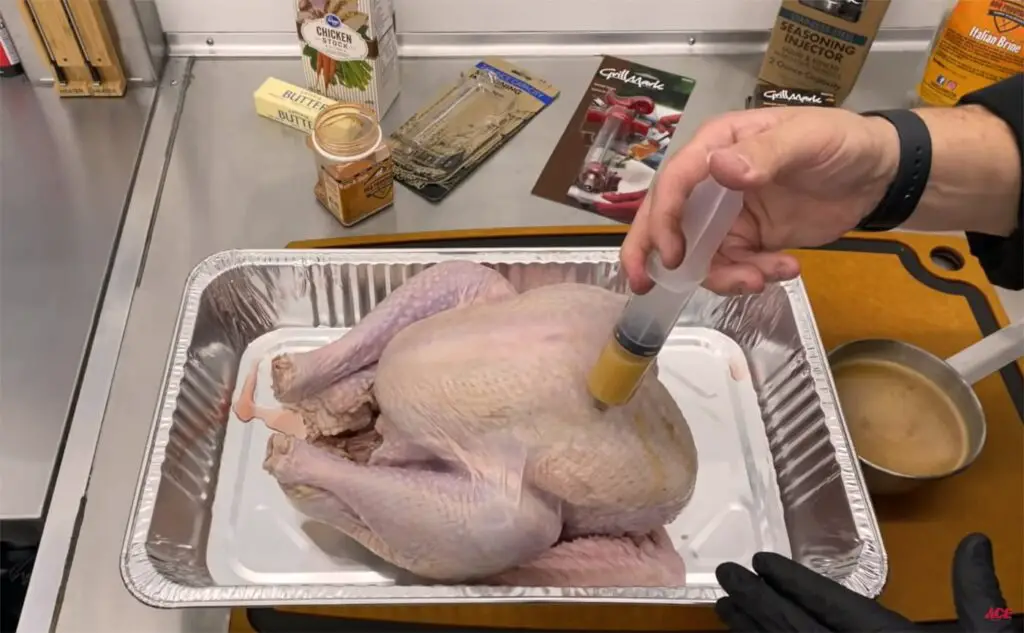Yes, Butterball turkeys are injected with a sodium solution. This enhances flavor and juiciness.
Butterball turkeys are popular during the holiday season. Many people choose them for their convenience and taste. These turkeys are pre-basted, which means they are injected with a solution that includes sodium. The sodium helps to retain moisture and improve flavor, making the turkey more succulent.
This process ensures that even novice cooks can serve a delicious, juicy bird. Always check the packaging for specific details about sodium content. This information is crucial for those monitoring their sodium intake. Butterball turkeys offer an easy and tasty option for festive meals. Make sure to follow cooking instructions for the best results.
Butterball Turkey Basics
Butterball turkeys are a favorite for many during the holidays. They are known for their tenderness and juiciness. Understanding what makes them unique is important.
What Sets Butterball Apart
Butterball turkeys are injected with a solution. This solution includes water, salt, and spices. The injection helps to keep the turkey moist. It also adds flavor. This makes cooking easier and results in a tastier bird.
Another key feature is the Butterball brand’s commitment to quality. They ensure their turkeys are free from hormones and steroids. Their turkeys are also raised in humane conditions. This attention to detail sets Butterball apart.
Popular Turkey Varieties
Butterball offers a range of turkey options. Below are some popular varieties:
| Type | Description |
|---|---|
| Whole Turkey | Perfect for large gatherings. Comes in various sizes. |
| Turkey Breast | Great for smaller meals. Easier to cook and carve. |
| Ground Turkey | Versatile option for various recipes. Low in fat. |
| Turkey Burgers | Pre-formed patties. Convenient for quick meals. |
Each variety has its own benefits. Whole turkeys are ideal for traditional feasts. Turkey breasts are a good choice for smaller families. Ground turkey and turkey burgers offer flexibility in meal planning.

Credit: www.butterball.com
Sodium Injection Process
The sodium injection process is a common practice with Butterball turkeys. This process ensures the turkey remains juicy and flavorful. Let’s dive into the specifics of why sodium is added and how the injection techniques work.
Why Sodium Is Added
Sodium helps to retain moisture in the turkey. This makes the meat tender and juicy. It also enhances the flavor, making the turkey more delicious. Below are some key points on why sodium is beneficial:
- Moisture Retention: Sodium traps water in the meat.
- Flavor Enhancement: It boosts the turkey’s natural flavor.
- Texture Improvement: Sodium makes the meat tender.
Injection Techniques
Butterball turkeys undergo a specialized injection process. This method ensures even distribution of sodium. Here are the common techniques used:
- Needle Injection: A needle injects sodium solution into the turkey.
- Multi-Needle Injection: Multiple needles inject the solution at once.
- Brining: The turkey is soaked in a sodium-rich solution.
Below is a table summarizing the techniques:
| Technique | Description |
|---|---|
| Needle Injection | Sodium solution injected with a single needle. |
| Multi-Needle Injection | Multiple needles inject the solution simultaneously. |
| Brining | Turkey soaked in a sodium-rich solution. |
Health Implications
Butterball turkeys are popular during the holidays. But many ask if they contain sodium injections. Sodium impacts health in various ways. Let’s explore the health implications.
Impact On Blood Pressure
High sodium levels can raise blood pressure. Elevated blood pressure leads to heart issues. Eating foods with high sodium increases these risks. Butterball turkeys may be high in sodium.
It’s crucial to monitor sodium intake. High blood pressure can affect people of all ages. Keeping sodium levels low promotes better health.
Sodium Intake Guidelines
Health experts provide sodium intake guidelines. The American Heart Association suggests no more than 1,500 mg daily. This is especially important for children and the elderly.
| Age Group | Recommended Sodium Intake |
|---|---|
| Children (4-8 years) | 1,200 mg |
| Children (9-13 years) | 1,500 mg |
| Adults | 1,500 mg |
Butterball turkeys can contain more sodium than these guidelines. Always check the label for sodium content. This helps in making healthier choices.
Eating lower sodium foods can protect your health. Choose fresh, non-processed meats to reduce sodium intake. This is an easy way to improve your diet.

Credit: www.butterball.com
Nutritional Comparison
Choosing the right turkey is important for a healthy meal. This includes considering the nutritional content. One question often arises: Are Butterball turkeys injected with sodium?
Butterball Vs. Other Brands
Butterball turkeys are famous for their juicy flavor. But, they are often injected with a sodium solution. This helps retain moisture and flavor during cooking. Here is a comparison:
| Brand | Sodium Content (mg per serving) |
|---|---|
| Butterball | 300 |
| Brand A | 150 |
| Brand B | 200 |
| Brand C | 100 |
This table shows Butterball turkeys have higher sodium content. Other brands often have lower sodium levels.
Fresh Vs. Frozen Turkeys
Fresh turkeys are usually not injected with sodium. Frozen turkeys often have added sodium for preservation. Here is a comparison:
- Fresh Butterball Turkeys: Lower sodium content, better for a low-sodium diet.
- Frozen Butterball Turkeys: Higher sodium content due to added solutions.
If you need a low-sodium meal, choose a fresh turkey. For juicy, flavorful meat, a frozen turkey may be better.
Consumer Concerns
Many consumers worry about the sodium content in Butterball turkeys. They wonder if these turkeys are injected with sodium. This concern is valid as too much sodium can be unhealthy. Let’s clear up some common misunderstandings and learn how to read labels correctly.
Common Misconceptions
Some people believe all Butterball turkeys are loaded with sodium. This is not true. Butterball offers different types of turkeys. Some are injected with a saline solution, while others are not. It’s important to know the difference.
Another misconception is that sodium injections make the turkey unhealthy. A small amount of sodium can help keep the meat juicy and flavorful. Not all sodium-injected turkeys are bad for you. Always check the specific product details.
Reading Labels Correctly
Reading labels correctly can help you make better choices. Here’s a simple guide:
- Look for the ingredient list on the package.
- Check for words like “enhanced” or “injected”.
- Note the amount of sodium per serving.
Butterball labels provide clear information. Here is an example of what to look for:
| Item | Details |
|---|---|
| Ingredients | Turkey, Water, Salt, Natural Flavors |
| Sodium per serving | 200mg |
By understanding the label, you can choose the best turkey for your family. If you prefer low-sodium options, select a turkey with less added sodium. This will help you enjoy a healthier meal.

Credit: nosaltnofatnosugar.com
Cooking With Butterball
Butterball turkeys are known for their juicy and tender meat. They come pre-seasoned with a special solution. This solution includes sodium, which enhances the flavor. Cooking with Butterball turkeys can be delightful. Below, we explore the nuances of flavor and sodium.
Flavor Enhancements
Butterball turkeys are injected with a sodium solution. This helps keep the meat moist and flavorful. The sodium solution includes broth, salt, and spices. These ingredients work together to enhance the natural taste of the turkey.
Here are some benefits of the sodium injection:
- Moisture retention: Keeps the turkey from drying out.
- Even seasoning: Ensures the entire turkey is flavorful.
- Ease of preparation: Reduces the need for additional seasoning.
Balancing Sodium In Recipes
Cooking with Butterball turkeys means managing sodium levels. While the turkey itself is seasoned, your recipes should balance this.
Here are some tips to balance sodium in your dishes:
- Use fresh herbs: Enhance flavors without adding more salt.
- Avoid canned broths: They often contain high sodium.
- Rinse canned beans: This can reduce sodium content.
- Opt for low-sodium sides: Pair with fresh vegetables and grains.
For a better understanding, see the table below:
| Ingredient | Alternative |
|---|---|
| Salted Butter | Unsalted Butter |
| Canned Vegetables | Fresh Vegetables |
| Regular Cheese | Low-Sodium Cheese |
These adjustments can help you enjoy a flavorful, well-balanced meal with Butterball turkey.
Alternatives To Butterball
Butterball turkeys are popular during Thanksgiving. But, they are injected with sodium. This can be a concern for some. So, exploring alternatives is important. Let’s dive into some options.
Low-sodium Options
Low-sodium turkeys are a great choice. They have less sodium content. Here are some brands to consider:
- Plainville Farms: Known for their low-sodium turkeys. They are also antibiotic-free.
- Applegate Farms: Offers turkeys with no added sodium. They are also free of nitrates.
- Bell & Evans: Their turkeys are minimally processed. They have low sodium levels.
Organic And Free-range Choices
Organic and free-range turkeys are healthier. They are raised without antibiotics. Here are some options:
- Diestel Family Ranch: Provides organic and free-range turkeys. They are also GMO-free.
- Mary’s Free-Range Turkeys: Known for their organic turkeys. They are also free-range and non-GMO.
- Willie Bird Turkeys: Offers free-range and organic options. They are known for their quality.
Choosing alternatives can be beneficial. It ensures healthier meals. Plus, it supports ethical farming practices.
Expert Opinions
Are Butterball turkeys injected with sodium? This question often arises during holiday planning. To offer clarity, we’ve gathered insights from experts. Below, we explore what nutritionists and chefs say.
Nutritionists’ Views
Nutritionists emphasize the importance of sodium levels in your diet. Butterball turkeys are injected with a saltwater solution. This makes the meat more flavorful and moist.
However, it increases the sodium content significantly. For those watching their sodium intake, this can be a concern. A typical serving might contain more sodium than you expect.
| Type of Turkey | Sodium Content (mg) |
|---|---|
| Butterball Turkey | 250-300 |
| Non-Injected Turkey | 70-80 |
Nutritionists recommend checking labels carefully. This helps you make an informed choice.
Chefs’ Recommendations
Chefs offer a different perspective on Butterball turkeys. Many chefs appreciate the added flavor and moisture. The sodium injection ensures consistent results.
For special occasions, a juicy and flavorful turkey is often preferred. Chefs suggest balancing the meal with low-sodium sides. This can help manage overall sodium intake.
Here are some tips from chefs:
- Pair with fresh vegetables
- Use herbs and spices for seasoning
- Prepare a low-sodium stuffing
These tips ensure a delicious and balanced holiday meal.
Frequently Asked Questions
What Is A Butterball Turkey Injected With?
Butterball turkeys are injected with a solution of water, salt, spices, and natural flavors to enhance juiciness and flavor.
Do Butterball Turkeys Have Salt Added?
Yes, Butterball turkeys have a salt solution added. This enhances flavor and helps retain moisture during cooking.
Is Butterball Turkey High In Sodium?
Yes, Butterball turkey can be high in sodium. Some products contain more than 200mg of sodium per serving. Always check the label.
Conclusion
Butterball turkeys are indeed injected with sodium for flavor and moisture retention. Knowing this helps you make informed choices. Opt for lower sodium options if needed. Always check labels for detailed nutritional information. Enjoy your turkey with awareness and savor the flavors responsibly.



